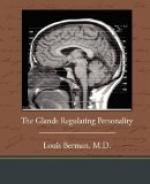The official biography by Sir Edward Cook contains three portraits, representing three different stages, which bear out the pituitocentric thesis of her personality and life history. One as she was at 25, and pictured by Mrs. Gaskell: “She is tall; very straight and willowy in figure; thick and shortish rich brown hair; very delicate complexion ... perfect teeth ... perfect grace and lovely appearance ... she is so like a saint.” The face is long and oval, of the post-pituitary kind. Then gradually the ante-pituitary gained an ascendency in the concert of her internal secretions, so coloring her life with its masculine tints, and altering her face as well as her disposition. The photograph of her taken when she was 38 shows a quadrangular outline, and all the acridity that impressed Strachey. The last picture of her, a water color drawing made in 1907, shows a round visaged old dame, who might be the peasant grandmother of two dozen descendants. Little patches of red over the cheek bones remind one of myxedema and indicate that toward the very end of her life her thyroid failed her as well as her pituitary. So that our biographer relates: “Then by Royal Command, the Order of Merit was brought to South Street, and there was a little ceremony of presentation. Sir Douglas Dawson, after a short speech, stepped forward and handed the order of the insignia to Miss Nightingale. Propped up by pillows, she dimly recognized that some compliment was being paid her. ‘Too kind—too kind!’ she murmured; and she was not ironical.” In the days of pituitary and thyroid hyperfunction we may be sure she would have been caustically and penetratingly ironical.
THE EXPLANATION OF OSCAR WILDE
The case of Oscar Wilde, as one of the high tragedies of English Literature and Life, attracted the attention of the whole world in its heyday, and even today evokes controversy. As a literary figure and artist, the poet of the Portrait of Dorian Gray, and “De Profundis,” belongs without a doubt to the immortals. As a convicted criminal, who served for two years at hard labor in Reading jail, and afterwards, a prey to chronic alcoholism, died in obscurity in Paris, he still remains a subject of whispered conversation in private, and his crime a taboo to the public, mentionable only at the risk of arousing the terrible odium sexicum of the prurient majority. Oscar Wilde was a homosexual of a certain type. In view of the previously laid down considerations concerning the endocrine genesis of homosexuality, how are we to explain him, and his natural history?
As with the other exemplars of genius examined we need here, too, to gain some insight into his “internal secretion heredity.” His father, Sir William Wilde, was a surgeon. Photographs of him show the long and broad face of a pituito-adrenal centered individual, with a corresponding duplex incarnation in the face, the upper half strikingly spiritual, the lower curiously animal.




